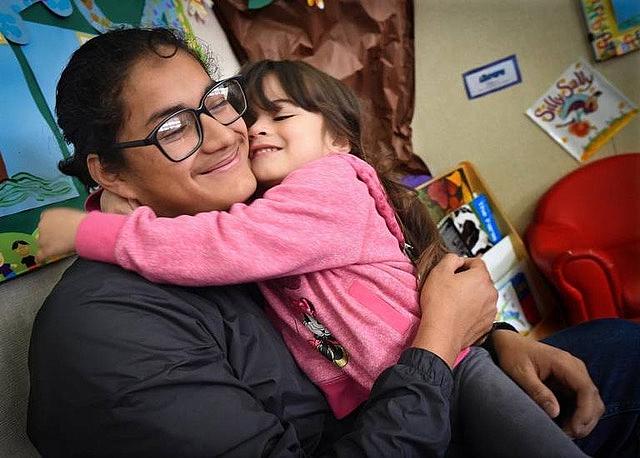How community engagement helped one reporter tell a fuller story of Fresno’s missing sex ed

Teen Dads: Three-year-old Emma gets in one more last-minute hug with her dad, 18-year-old Kevin Aguilar, after he drops her off at day care before he begins his day at Fresno’s School of Unlimited Learning. (Photo: John Walker/The Fresno Bee)
When I set out on the community engagement fellowship, I knew what group I wanted to focus on — and that it wouldn’t be easy. My project was about the Central Valley’s high teen pregnancy rates and a new state law that mandates sex education in schools, something our conservative region has resisted for years. My seven-part series focused on health, education, policy and more, but I wanted to hear from teen parents, and teens in general, not just the experts.
As an education reporter, I’m always telling stories about young people and the decisions that impact them, but access to honest interviews with them are limited. I wanted to allow teens to speak for themselves. Regardless of your beat, there are members of your community that often feel inaccessible, guarded or hard to reach. Community engagement forces you to rethink your reporting techniques, and can connect you with sources that are so valuable but often overlooked.
As part of my fellowship, I conducted an anonymous survey of Fresno high school students and allowed them — not school administrators — to speak directly about what they had (or hadn’t learned) regarding sex education. I set up simple “listening posts” made of cardboard, a mic and a recorder at youth programs across the county, allowing teens to anonymously and candidly talk about their experiences with sexual health, and what they wish they had learned.
The community engagement process pushed me out of my reporting comfort zone, and not only led to new sources but strengthened the relationships I had with previous sources.
For example, in the midst of my fellowship reporting, a school official approached me about a headline in one of my stories that used the word “delinquent” to describe the student body at an alternative school. In the past, she may have emailed me or my editors about it, but she said she now felt like she could confront me honestly because of the engagement work that I had done with her and her students. Before, I would have directed her to my editor and explained my paper’s policies on headlines. But instead, I offered to come back to her student group and to hear their concerns about it, and also to teach them a little about journalism and headline writing. She loved the idea. I realized that the fellowship had totally changed my way of thinking — and listening.
Here are some of the biggest lessons I learned during my community engagement process:
1. Don’t give up easily. People don’t like change. New reporting techniques mean you may meet resistance or skepticism. If your sources seem concerned, be honest with them about your goals, hear them out and be willing to compromise. Explain to them the value in telling the story in new ways and what doing so can offer your community compared to more traditional storytelling techniques.
In the case of my project, there were attempts made by an elected official to stop my survey, but more than 150 students volunteered to take it. And ultimately, it showed that nearly 90 percent of them weren’t learning sex ed lessons now mandated by state law. I would not have been able to shed that kind of light on the issue otherwise. This goes for your editors, too. Make sure you’re committed to your engagement plan, and that it’s doable, before you present it to your newsroom. Some of your ideas may make management scratch their head, but nonetheless push them to take new risks.
2. Listen. That’s the point of all this. You may have an image in your mind of what your project is going to look like, but don’t hold on too tight to that. Your community engagement plans will likely change — a lot — and that’s OK. Since this project started six months ago, my initial plans went from hosting some sort of health fair to holding an event for teachers. Neither of those things happened. That’s because as my work continued, I learned from my community that teen dads, and boys in general, were an overlooked group in these discussions — so that’s where I focused my engagement efforts. Meet people for coffee, host listening sessions, put a call out on social media and find out what your community thinks of your ideas. They may offer up a venue or idea that you haven’t thought of. That kind of planning process in and of itself qualifies as its own form of community engagement, in my opinion.
3. Remember you’re still a reporter. At the end of the day, community engagement is supposed to influence and enhance your reporting. If you find that it hasn’t, it may be time to change course. When you’re in the thick of it, it can be hard to discern, since this isn’t the typical daily coverage you’re used to and you often become more invested in the people you’re working with. Sometimes I had to make hard decisions about whether something would be a valuable addition to my project. I transcribed audio from the listening posts and folded them into my stories, and also offered it up to local radio stations. I tried to use every aspect of engagement in my stories, even if it just meant listening to youth voices to steer the coverage or identify general themes. Like journalism, the community engagement component is a public service. But don’t lose sight of your top priority, which is to tell the story.
Read Mackenzie May's fellowship stories here.

